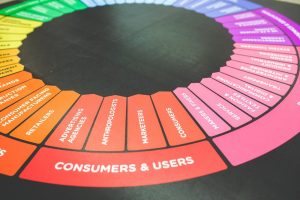The Buyer’s Journey
One of the most basic, but important, principles in marketing, the buyer’s journey is a customer-centric business model that illustrates how people go from lead to customer.
A generally-accepted model of the buyer’s journey is broken down into 5 steps: Awareness, Opinion, Consideration, Preference, and Purchase. With the sales funnel in mind, businesses have to build a marketing effort that addresses the possible considerations people go through in every step, i.e. what collaterals will help raise your brand presence in the awareness stage, how do you sway the customers opinions to your brand, what can you do to make your brand their preferred choice, and how do you convince them to purchase from your brand.
Every budding entrepreneur should read up on the Buyer’s Journey, and while it’s not a be-all-or-end-all marketing model, it is one of the most effective ways to run a business. Luckily, free resources regarding this (and many other marketing principles) online, although consulting with a professional marketer won’t hurt either.
(Marketing) Mix it Up
 Also known as the “4 P’s in Marketing”, the Marketing Mix is a foundation model in marketing first conceived by American academic Neil Borden in the early 20th century. The 4 P’s refer to: Product, Price, Promotion, and Place. This concept was designed to help entrepreneurs come up with a business strategy that incorporates all aspects of their marketing efforts into an easy-to-digest form.
Also known as the “4 P’s in Marketing”, the Marketing Mix is a foundation model in marketing first conceived by American academic Neil Borden in the early 20th century. The 4 P’s refer to: Product, Price, Promotion, and Place. This concept was designed to help entrepreneurs come up with a business strategy that incorporates all aspects of their marketing efforts into an easy-to-digest form.
Products can either be tangible goods or an intangible service or services. Either way, the Marketing Mix model encourages entrepreneurs to have a firm and clear vision of their product. In this way, businesses can have a more effective way of marketing it.
Once a product has been clearly defined, its Price must then be determined. A product’s price not only dictates a company’s profit margins, it also affects the overall marketing strategy. Small businesses should come up with appropriate price points, and consider the elasticity of prices as well.
Once a product has been developed and a price point established, it’s time to promote it. Promotion is the main form of disseminating all marketing collaterals regarding the brand. For small businesses, this should be done in accordance with your target market, and in what stage of the buyer’s journey you would like to capture your customers.
The last factor, Place, is concerned with where a marketing effort will be. This is entirely dependent on where your target market spends their time, whether it’s on the street or online. To effectively place marketing efforts in the right place and time, it’s essential for small businesses to have an understanding of their market (more on this later).
As with the Buyer’s Journey, the Marketing Mix is not the right way to market your brand, but it has a proven track record of success and is aimed at giving small entrepreneurs a solid foundation to start their marketing efforts.
Know Your Audience
 In essence, marketing is all about convincing someone that they need your brand. And while this is true, it’s also important to remember that modern customers are no longer swayed by brand-centric marketing efforts. Today, people want to make a personal connection with the brands they purchase.
In essence, marketing is all about convincing someone that they need your brand. And while this is true, it’s also important to remember that modern customers are no longer swayed by brand-centric marketing efforts. Today, people want to make a personal connection with the brands they purchase.
The best way to do this is to understand your customers on a human level. Get to know them through surveys, sponsored events, social media posts, and the like. Not only does this help you establish a solid psychographic model of your customer-base and create marketing collaterals that help establish a personal connection with your brand, it also helps you strategize where and when to deploy your marketing efforts.
Small businesses should take the time to establish who their target market is, understand their customer’s personal wants and needs, and devise a strategy that addresses their unique issues.
Determine a USP
More than a logo or any other branding effort, a product’s USP, or Unique Selling Point, is the factor that differentiates it from its competitors. A business’ USP gives it a competitive edge and creates opportunities for companies to expand their brand presence via the uniqueness of their product.
This is one of the crucial aspects of a product that can sway public opinion and make your product the brand of choice for consumers. But only if it’s done right.
Determining a product’s USP requires an intimate understanding of your market (see above), but also an understanding of the industry you’re in. Find out what the standards are for similar products in your industry, and figure out how you can elevate your product from it while still being able to address your market’s needs. Communicate your USP at every opportunity, and let it be one of the focal points of your marketing strategy.
Be FABulous
![]() No, we don’t mean being flashy and glamorous (although, if that’s your target market…), we mean focusing on F.A.B: Features, Advantages, and Benefits. With every marketing effort, FAB statements must be made about your products uniqueness (feature), what it does (advantages), and how it adds value (benefits) to the customer. FAB statements should be included in every marketing and sales message.
No, we don’t mean being flashy and glamorous (although, if that’s your target market…), we mean focusing on F.A.B: Features, Advantages, and Benefits. With every marketing effort, FAB statements must be made about your products uniqueness (feature), what it does (advantages), and how it adds value (benefits) to the customer. FAB statements should be included in every marketing and sales message.
Features are the basic characteristics of your product. This part of your marketing message should talk about what your product has, while advantages talks about what your product can do. Benefits is the most important part: it’s the part that’s designed to convince your customer that they need your product because of the value it brings them.
Again, defining your product’s FAB is determined by how defined your product is and your understanding of your market and the industry as a whole.
As with many things, consistency is a key factor in the success of any marketing strategy. More so for small businesses, consistency of message, quality, price point, and service dictates how far your product will go. By using basic marketing principles and understanding your customers, small businesses can elevate themselves above the competition and create a strong brand presence in their industry.
